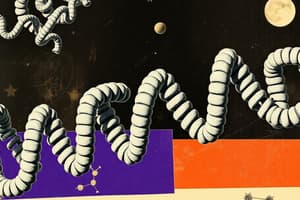Podcast
Questions and Answers
What type of bond links amino acids together to form a polypeptide?
What type of bond links amino acids together to form a polypeptide?
- Hydrogen bond
- Peptide bond (correct)
- Ionic bond
- Disulfide bond
Which structural level in a protein is defined by its unique sequence of amino acids?
Which structural level in a protein is defined by its unique sequence of amino acids?
- Quaternary structure
- Primary structure (correct)
- Secondary structure
- Tertiary structure
What happens to a protein when it denatures?
What happens to a protein when it denatures?
- It forms stronger peptide bonds between its amino acids.
- It retains its functional shape and properties.
- It gains a more complex quaternary structure.
- It loses its higher-level structure and function. (correct)
Which of the following is an example of a conjugated protein?
Which of the following is an example of a conjugated protein?
The interactions between which groups are MOST responsible for a protein's tertiary structure?
The interactions between which groups are MOST responsible for a protein's tertiary structure?
Flashcards
Primary Protein Structure
Primary Protein Structure
The linear sequence of amino acids in a protein chain.
Secondary Protein Structure
Secondary Protein Structure
The three-dimensional shape formed by hydrogen bonds between amino acids within the polypeptide chain.
Tertiary Protein Structure
Tertiary Protein Structure
The overall three-dimensional shape of a single polypeptide chain, determined by interactions between R-groups.
Quaternary Protein Structure
Quaternary Protein Structure
Signup and view all the flashcards
Protein Denaturation
Protein Denaturation
Signup and view all the flashcards
Study Notes
Protein Structure
- Amino acids are the building blocks of proteins
- Proteins are made of carbon, hydrogen, nitrogen, and oxygen
- There are 20 different amino acids, each with a unique R group
- Peptide bonds hold amino acids together in a dehydration reaction
- Polypeptides are chains of amino acids, with a nitrogen (N) and a carboxyl (C) terminal end
- Conjugated proteins have a non-protein component, like an ion or carbohydrate
- Primary structure is the sequence of amino acids
- Secondary structure is the folding pattern of the amino acid chain (e.g., alpha-helices, beta-sheets)
- Tertiary structure is the three-dimensional shape of a polypeptide, determined by interactions between R groups
- Quaternary structure is the arrangement of multiple tertiary proteins
- Denatured proteins lose their higher level structure, and therefore function
- Proteins have various functions, including: storing amino acids, producing hormones, signaling, providing structural support, creating immunity, and catalyzing reactions (enzymatic activity)
Studying That Suits You
Use AI to generate personalized quizzes and flashcards to suit your learning preferences.




